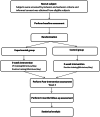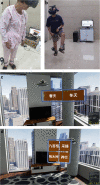Evaluating the effect of immersive virtual reality technology on gait rehabilitation in stroke patients: a study protocol for a randomized controlled trial
- PMID: 33494805
- PMCID: PMC7836462
- DOI: 10.1186/s13063-021-05031-z
Evaluating the effect of immersive virtual reality technology on gait rehabilitation in stroke patients: a study protocol for a randomized controlled trial
Abstract
Background: The high incidence of cerebral apoplexy makes it one of the most important causes of adult disability. Gait disorder is one of the hallmark symptoms in the sequelae of cerebral apoplexy. The recovery of walking ability is critical for improving patients' quality of life. Innovative virtual reality technology has been widely used in post-stroke rehabilitation, whose effectiveness and safety have been widely verified. To date, however, there are few studies evaluating the effect of immersive virtual reality on stroke-related gait rehabilitation. This study outlines the application of immersive VR-assisted rehabilitation for gait rehabilitation of stroke patients for comparative evaluation with traditional rehabilitation.
Methods: The study describes a prospective, randomized controlled clinical trial. Thirty-six stroke patients will be screened and enrolled as subjects within 1 month of initial stroke and randomized into two groups. The VRT group (n = 18) will receive VR-assisted training (30 min) 5 days/week for 3 weeks. The non-VRT group (n = 18) will receive functional gait rehabilitation training (30 min) 5 days/week for 3 weeks. The primary outcomes and secondary outcomes will be conducted before intervention, 3 weeks after intervention, and 6 months after intervention. The primary outcomes will include time "up & go" test (TUGT). The secondary outcomes will include MMT muscle strength grading standard (MMT), Fugal-Meyer scale (FMA), motor function assessment scale (MAS), improved Barthel index scale (ADL), step with maximum knee angle, total support time, step frequency, step length, pace, and stride length.
Discussion: Virtual reality is an innovative technology with broad applications, current and prospective. Immersive VR-assisted rehabilitation in patients with vivid treatment scenarios in the form of virtual games will stimulate patients' interest through active participation. The feedback of VR games can also provide patients with performance awareness and effect feedback, which could be incentivizing. This study may reveal an improved method of stroke rehabilitation which can be helpful for clinical decision-making and future practice.
Trial registration: Chinese Clinical Trial Registry ChiCTR1900025375 . Registered on 25 August 2019.
Keywords: Gait rehabilitation; Immersive virtual reality; Randomized controlled trials; Stroke rehabilitation.
Conflict of interest statement
The authors state that they have no competing interests.
Figures




Similar articles
-
Virtual reality gait training versus non-virtual reality gait training for improving participation in subacute stroke survivors: study protocol of the ViRTAS randomized controlled trial.Trials. 2019 Jan 29;20(1):89. doi: 10.1186/s13063-018-3165-7. Trials. 2019. PMID: 30696491 Free PMC article.
-
Evaluating the effect and mechanism of upper limb motor function recovery induced by immersive virtual-reality-based rehabilitation for subacute stroke subjects: study protocol for a randomized controlled trial.Trials. 2019 Feb 6;20(1):104. doi: 10.1186/s13063-019-3177-y. Trials. 2019. PMID: 30728055 Free PMC article.
-
Effects of VR task-oriented training combined with rTMS on balance function and brain plasticity in stroke patients: a randomized controlled trial study protocol.Trials. 2024 Oct 21;25(1):702. doi: 10.1186/s13063-024-08519-6. Trials. 2024. PMID: 39434192 Free PMC article.
-
Effect of Traditional Plus Virtual Reality Rehabilitation on Prognosis of Stroke Survivors: A Systematic Review and Meta-Analysis of Randomized Controlled Trials.Am J Phys Med Rehabil. 2022 Mar 1;101(3):217-228. doi: 10.1097/PHM.0000000000001775. Am J Phys Med Rehabil. 2022. PMID: 33929347
-
Virtual reality in the rehabilitation of patients with stroke: an integrative review.Arq Neuropsiquiatr. 2019 May 13;77(4):268-278. doi: 10.1590/0004-282X20190025. Arq Neuropsiquiatr. 2019. PMID: 31090808 Review.
Cited by
-
Using Logistic Multivariate Analysis to Explore the Effects of Nursing and Psychological Factors on Motor and Cognitive Rehabilitation in Patients with Stroke: Based on a Retrospective Case-Control Study.Comput Intell Neurosci. 2022 Aug 19;2022:1411670. doi: 10.1155/2022/1411670. eCollection 2022. Comput Intell Neurosci. 2022. PMID: 36035851 Free PMC article.
-
Exploring the Potential of Immersive Virtual Reality in the Treatment of Unilateral Spatial Neglect Due to Stroke: A Comprehensive Systematic Review.Brain Sci. 2022 Nov 20;12(11):1589. doi: 10.3390/brainsci12111589. Brain Sci. 2022. PMID: 36421913 Free PMC article. Review.
-
Personalized Video-Based Educational Platform to Improve Stroke Knowledge: A Randomized Clinical Trial.J Am Heart Assoc. 2024 Aug 6;13(15):e035176. doi: 10.1161/JAHA.124.035176. Epub 2024 Jul 31. J Am Heart Assoc. 2024. PMID: 39082426 Free PMC article. Clinical Trial.
-
RehaBEElitation: the architecture and organization of a serious game to evaluate motor signs in Parkinson's disease.PeerJ Comput Sci. 2023 Mar 15;9:e1267. doi: 10.7717/peerj-cs.1267. eCollection 2023. PeerJ Comput Sci. 2023. PMID: 37346638 Free PMC article.
-
Interventions to improve outdoor mobility among people living with disabilities: A systematic review.Campbell Syst Rev. 2024 Jun 14;20(2):e1407. doi: 10.1002/cl2.1407. eCollection 2024 Jun. Campbell Syst Rev. 2024. PMID: 38882933 Free PMC article. Review.
References
-
- de Rooij I, van de Port I, JJPt M. Effect of virtual reality training on balance and gait ability in patients with stroke: systematic review and meta-analysis. Phys Ther. 2016;96(12):1905–18. - PubMed
-
- Olney SJ, Griffin MP, Monga TN, McBride ID. Work and power in gait of stroke patients. Arch Phys Med Rehabil. 1991;72:309–14. - PubMed
Publication types
MeSH terms
Grants and funding
LinkOut - more resources
Full Text Sources
Other Literature Sources
Medical

